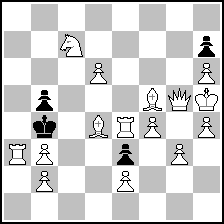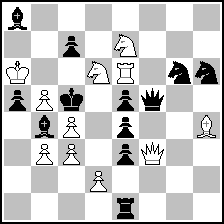
Website founded by
Milan Velimirović
in 2006
11:03 UTC


| |
MatPlus.Net  Forum Forum  General General  Number and type of sacrifices Number and type of sacrifices |
| |
|
|
|
|
You can only view this page!
| | | (1) Posted by Steven Dowd [Saturday, May 30, 2009 17:28]; edited by Steven Dowd [09-05-30] | Number and type of sacrifices
In his book Meritter - en samling sjakkproblemer, Nils Adrian Bakke has a s#8 of his with 8 piece sacrifices:
 (= 10+2 ) (= 10+2 )
As with many of Bakke's problems, the solution is not as hard to find as it probably was to construct it (this is a compliment, not an insult, and the key is quite nice):
1. f8=B Rxb8 2. Qa4+ Kxb7 3. Rb1+ Kxc8 4. Qc4+ Kxd8 5. Rd1+ Kxe8 6. Qe6+ Kxf8 7. Rd8+ Rxd8 8. Qf7+ Kxf7#
I can usually wade throught most Nordic languages and in the book I think he indicates Najdorf once had a game with the sacrifice of five officers (Leste es sted at Miguel Najdorf ofret 5 offiserer i et sjakkparti). But if he is referring to the Polish Immortal, that was 4 pieces sacrificed, correct (the Polish Immortal is of course in Wikipedia for anyone who cares to look)?
Eight in eight must be a record, or close. Did someone do nine in nine?
Now there is an interesting note to a selfmate in the Chlubna Jubilee tourney:
Wilfried Neef
Lob (ohne Rangfolge)
Chlubna Jubilee 1997
 (= 15+4 ) (= 15+4 )
1. Bc5+ Kxc5 2. Ra6 b4 3. Rd4 Kxd4 4. Be4 Kxe4 5. Qg7 Kf5 6. Qg6+ hxg6#
Chlubna and Wenda, in the tournament report say that what appear to be Hineinziehungsopfer are actually Kraftopfer, it would appear to me that they serve both purposes since no mate is possible without the king being pulled into the net.
They also note that "drei hintereinandergeschaltete Kraftopfer sind in einem Mattproblem hoechstwahrscheinlich undarstellbar." They note this gives the problem that special selfmate "character".
Well, again unless my eyes deceive me, there are three such sacrifices but wouldn't "hintereinandergeschaltetete" mean in a row or am I misreading that? There is an intermediary move of 2. Ra6.
Also I haven't tried it, but three Kraftopfer in a row in a mate problem seems highly possible, or what am I overlooking?
| | | (2) Posted by Thomas Maeder [Saturday, May 30, 2009 21:02] |
QUOTE
They also note that "drei hintereinandergeschaltete Kraftopfer sind in einem Mattproblem hoechstwahrscheinlich undarstellbar." They note this gives the problem that special selfmate "character".
Well, again unless my eyes deceive me, there are three such sacrifices but wouldn't "hintereinandergeschaltetete" mean in a row or am I misreading that? There is an intermediary move of 2. Ra6.
It does not mean "in a row"; they just have to occur in the same line - as opposed to occuring in different variations.
| | | (3) Posted by Steven Dowd [Saturday, May 30, 2009 21:31] |
Thanks Thomas... I doubted that Chlubna and Wenda could make a mistake I could spot. Then the whole comment makes much more sense. That does seem very difficult in a directmate context then.
For those interested, I wonder if this h# by Klasinc (one of too many underappreciated h# artists) is the record for consecutive sacrifices in a helpmate.
Marko Klasinc
Schach-Echo 1972
h#6
 (= 12+11 ) (= 12+11 )
1.Bd6-c5 Sd5-b4 2.Bc5-b4 Se4-c3 3.Bb4-c3 Lc6-f3 4.Bg4-f3 Tb6-g6 5.Bh7-g6 Bg3-g4 6.Bg6-f5 Lh2-f4#
One move set, 2 passive sacrifices, 4 active sacrifices.
| | | (4) Posted by Harry Fougiaxis [Monday, Jun 1, 2009 10:09]; edited by Harry Fougiaxis [09-06-01] |
Maybe off-topic, but personally I never liked the expression "active" and "passive" sacrifice. To me, passive sacrifice is capture of a disturbing (*) unit which has not previously moved, whereas active sacrifice is simply sacrifice of a piece that moves itself to the square and it is later captured.
(*) Of course, it includes those cases where the unit is not in fact disturbing, but it is captured accidentally, i.e. Black has to play to a certain square and a white unit merely happens to stand on that square.
| | | (5) Posted by Steven Dowd [Monday, Jun 1, 2009 17:46]; edited by Steven Dowd [09-06-01] |
It's not off-topic, Harry, but after reading your post I cannot determine *why* you think the differentiation is not a particularly valid one.
I think it is, this being one of the reasons:
Jozsef Korponai
Magyar Sakkélet 02/1962
Lob
Blathy Memorial
h#7
 (= 8+2 ) (= 8+2 )
Which I noticed you C+d in 2006 in the PDB. I've not done a computer check, but near as I can determine the capture of the bishop on h1 is superfluous, the king needs to capture the bishop since h1 is the only square he can go to.
In opposition, I would like to offer Elkies wonderful Problemist problem, h#9,5, also with promoted bishops, with 1. ...La8-h1 2. Kxh1, but I can't find it. Even though forced, that sacrifice is a wonderul active sacrifice that also clears the promotion square for a pawn......
| | | (6) Posted by Joost de Heer [Monday, Jun 1, 2009 17:55] |
Noam Elkies, The Problemist 2004
 (= 9+1 ) (= 9+1 )
h#10
| | | (7) Posted by Harry Fougiaxis [Tuesday, Jun 2, 2009 09:10] |
QUOTE
It's not off-topic, Harry, but after reading your post I cannot determine *why* you think the differentiation is not a particularly valid one.
I feel it may not be quite clear what I mean. What I'm trying to say is that I prefer the term "capture of a white unit" instead of "passive sacrifice", and "sacrifice" instead of "active sacrifice". Of course, if one decides to adopt the term "sacrifice" for both, then he/she should also differentiate by using the proper adjective. It's only semantics, I agree, but I think it's more clear this way.
| | | (8) Posted by Zalmen Kornin [Tuesday, Jun 2, 2009 15:09]; edited by Zalmen Kornin [09-06-05] |
quote "drei hintereinandergeschaltete Kraftopfer sind in einem Mattproblem hoechstwahrscheinlich undarstellbar."
What exactly they mean? If we count the key as a "Kraftopfer" (and with a -1 threat that's the case...) three "drei hintereinandergeschaltete" can be shown in at least two different forms in a same four-mover. Or?! (*** as seen below in the other posts, the German term Kraftopfer meaning is not that supposed here - note added 5-vi)
Z Kornin
"Probleemblad" 1999
 (= 11+12 ) (= 11+12 )
#4
I'll not give the key for benefit of those wishing to solve, but after the key I count three sacrifices in each of the variations 1...Bc6/Qf3. The main idea of the problem is the transference of the pair of Knights from a diagonal to another, from a3-f8 to h1-a8, with mate arriving alternativelly in both lines, being cleared, so to say, by the movement or the aniquilation of the same Knights. A flight mate with Rd5/ke6/Nd8 is a good add, but a dutch solver praised just the "display of fireworks"
| | | (9) Posted by Steven Dowd [Tuesday, Jun 2, 2009 21:27] |
That makes sense, Harry. Thanks for the clarification.
I find it interesting we are discussing this 70 years after Spielmann noted problemists had every type of sacrifice exactly categorized.......
| | | (10) Posted by Hauke Reddmann [Wednesday, Jun 3, 2009 11:22] |
Just to clarify, the only motif that can justify a
"Kraftopfer" in a n# is stalemate!
In a selfmate, things are a bit different.
Check the Neef problem: The bishops and the rook
could move somewhere else, but the black King must
walk over their start field and thus the only way to
get rid of them is to sacrifice them beforehand.
Hauke
| | | (11) Posted by Joost de Heer [Wednesday, Jun 3, 2009 12:06] |
Square vacation can be a motive for a Kraftopfer, as shown for example in Grasemann's famous #6:
 (= 4+8 ) (= 4+8 )
| | | (12) Posted by Sarah Hornecker [Wednesday, Jun 3, 2009 12:08] |
Isn't this rather a Räumungsopfer then?
| | | (13) Posted by Steven Dowd [Wednesday, Jun 3, 2009 16:40] |
Hauke's comment regarding the Kraftopfer and stalemate/Patt is well demonstrated in Siers' article on Kraftopfer, which is in the excellent Knightrider Siers book Ro'sselspru'nge.
| | | (14) Posted by Steven Dowd [Wednesday, Jun 3, 2009 17:24] |
I think you are right, Siegfried. Maybe Dr. Rehm will discuss this in his upcoming article. I see no Pattgefahr ("danger of stalemate"), so I see this as a Rau'mungsopfer zwecks Beseitigung hinderliche Weisse Masse (clearance sacrifice with the goal of removing superfluous white material), so that the WS can, ala Bonus Socius, access f5 and then g3.
| | | (15) Posted by Hauke Reddmann [Thursday, Jun 4, 2009 10:46] |
Yup, here the Masse (mass) is in the way, not the Kraft (force)
of the piece.
Hauke
| | | (16) Posted by Zalmen Kornin [Thursday, Jun 4, 2009 18:20]; edited by Zalmen Kornin [09-06-04] |
Yes, "Räumungsopfer usw" or in SH fine translation 'clearance sacrifice with the goal of removing superfluous white material', and not "Kraftopfer" - and, of course, Chlubna & Wenda's assertion is right - "drei hintereinandergeschaltete" etc are really "höchstwahrscheinlich undarstellbar." (Moreover, in my #4 there's just a blend, a combination of different forms of sacrifice in the variations 1...Bc3/Qf3/Bc6. Some "Räumung". but also hopefully "Lenkung" , "Beugung", and at least one bonus "Hineinziehung" (but definetivelly no "Kraftopfer", like in an Indian or in a Cheney-Loyd}
| |
No more posts |
MatPlus.Net  Forum Forum  General General  Number and type of sacrifices Number and type of sacrifices |
|
|
|
 ISC 2025
ISC 2025 Forum
Forum  General
General  Number and type of sacrifices
Number and type of sacrifices 


